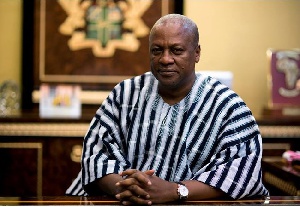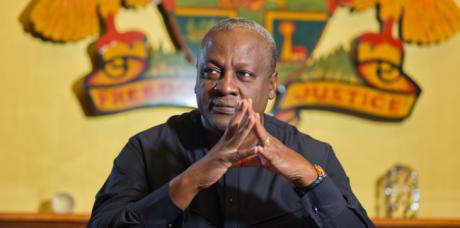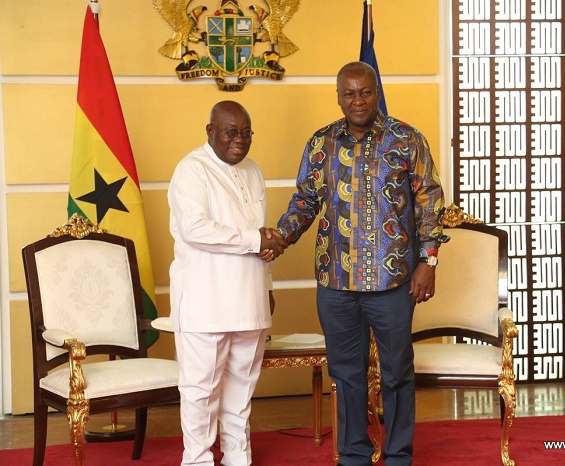 Former President John Dramani Mahama
Former President John Dramani Mahama
Just 365 days after transferring power from former president to incumbent president, most of the Ghanaian media networks are abusing the presidential coat of arms of Ghana which is serious.
On January 7, 2017, former president John Dramani Mahama through a ceremony at parliament house handed over power as president of the Republic of Ghana to Nana Addo Dankwa Akufo Addo who was elected in a presidential election held on December 7, 2016.
Meaning, former president John Dramani Mahama ceased to hold himself as an incumbent president, ceased enjoying the title, “His excellency” and the use of the presidential coat of arms in any form of communicating to Ghanaians.
However, just after 365 days that the former president walked free from heavy security of the presidential office, presidential residency as he turned an ordinary citizen of Ghana, some politicians from both New Patriotic Party NPP and National Democratic Congress NDC, party communicators, some journalists and ordinary persons intentionally or unintentionally are still referring to Mr. John Mahama as “President Mahama”.
What makes it worse is that certain media houses knowingly or unknowingly are still publishing stories of him with presidential coat of arms at the background.
Enjoying this hypocrisy, some members of the opposition NDC are defending the criminal act by saying there is nothing wrong about the usage of their “idol” Mr. Mahama’s picture with the coat of arms at the background now that he is no more the president, whiles others are pointing out that such act contravenes the Flag and Arms Protection Act of 1959/61.
Among the media networks noted for contravening or abusing the coat of arms, Ghana Web seems to be topping the list where it publishes most of its stories with photos of Mr. John Mahama with the coat of arms at the background since he handed over power as the president after 365 clear days to Nana Akufo Addo as the incumbent.
EXAMPLES TO SHOW
Though captioned former president John Dramani Mahama Ghana Web on January 2, 2018, on its opinion page, published two articles with a photograph of him with the presidential seal or the coat of arms at the background.
The first article with the wrong portrait of him was titled, “JM releases attack dogs on professor Alabi” and it was written by Murtala Abubakar Mohamad, a columnist.
And the second typical example or evidence of abuse of the coat of arms was the article titled, “John Mahama must cage Stan Dogbe from his foolery and nonsense idiocy” and was written by Efo Dela also a columnist.

If the media networks haven’t taken note of that, they must be reminded of how they are causing confusion in the system by swelling the debate of who is the incumbent president of Ghana by continuously publishing photos of Mr. Maham with the coat of arms at the background since he is no more the president.
HISTORY OF THE COAT OF ARMS
The coat of arms which is also the presidential seal of Ghana, was designed by a Ghanaian artist Mr. Amon Kotei and was adopted on March 4, 1959.
The national coat of arms of Ghana or the presidential seal is composed of a shield, divided into four quarters by a green St. George cross, rimmed with gold.
Either the coat of arms or the presidential seal of Ghana is used to mark correspondence from the incumbent president of Ghana and not from a former president of Ghana to parliament, ministries, and government agencies and to ordinary citizens who the president may authorize to perform a duty.
Other versions of the coat of arms and the presidential seal are often used as visual symbol to represent the president and only a sitting president, and are most often seen: on lectern at presidential press conferences, on the sides of the presidential transports, at the background of presidential office and many more. The coat of arms and the presidential seal has a wider usage.

THE FLAG AND ARMS PROTECTION ACT 1959/61
The Flag and Arms Protection Act 1959/61, states that and I quote: “Any person who contravenes the provisions of this act commit an offence and shall be liable on summary conviction to a fine”. If the design is used upon, or in connection with goods, the law says, “The fine shall be increased by an additional amount equal to the retail value of any such goods… or the goods may be confiscated altogether”.
In the United States of America, the use of the presidential seal or the coat of arms by any person except the president, or the publication of a photograph with a person not a president with the seal on a lectern or coat of arms at the background is termed as abuse of the presidential seal or coat of arms which is a crime punishable by six [6] months in jail.
In a recent U.S. presidential campaign season, the Democrat presidential candidate Hillary Clinton was blamed for abusing the presidential seal or the coat of arms of America.
At a campaign event in North Carolina, then President Barack Hussein Obama spoke before Hillary Clinton and used the official presidential seal or the coat of arms of America for his remarks.
When Hillary Clinton stepped up to the lectern the presidential seal or the coat of arms wasn’t taken down, but instead used by Hillary Clinton for her remarks as well.
This created a huge debate of abuse of the presidential seal and coat of arms by Mrs. Hillary Clinton and the future occurrence of that error was avoided by the white house graphics and Calligraphy office which monitors unofficial use of the presidential seal, the coat of arms and its regulations.
By law, whoever knowingly or unknowingly displays any printed or likeness of the great seal of the president or the coat of arms of Ghana, the president, the seal of parliament, or any photograph of a person who is not the president should know is abusing the presidential seal or the coat of arms and shall be fined under the flag and arms protection act 1959/61.
It is now the duty of the graphics and Calligraphy office at the Flag Staff House, the national security and the ministry of interior through ministry of information to raise awareness of the abuse and monitor unofficial use of the presidential seal or the coat of arms and its regulations in order to give respect to the president and the country Ghana.